软件工程第八版(英文)机械工业出版社 课后习题
- 格式:doc
- 大小:4.32 MB
- 文档页数:29
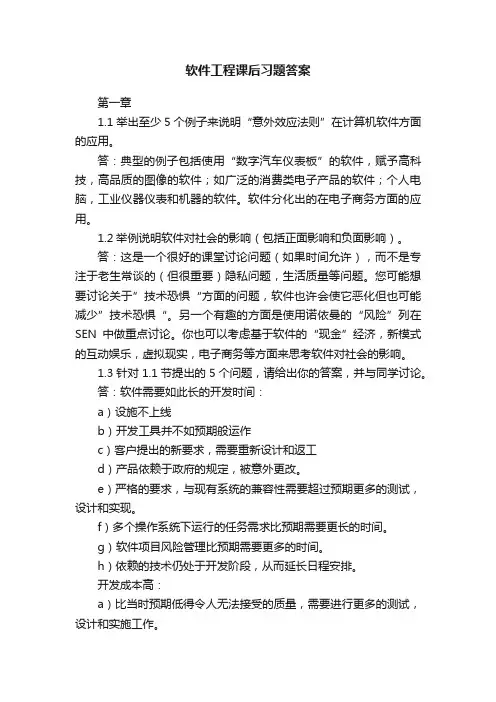
软件工程课后习题答案第一章1.1举出至少5个例子来说明“意外效应法则”在计算机软件方面的应用。
答:典型的例子包括使用“数字汽车仪表板”的软件,赋予高科技,高品质的图像的软件;如广泛的消费类电子产品的软件;个人电脑,工业仪器仪表和机器的软件。
软件分化出的在电子商务方面的应用。
1.2举例说明软件对社会的影响(包括正面影响和负面影响)。
答:这是一个很好的课堂讨论问题(如果时间允许),而不是专注于老生常谈的(但很重要)隐私问题,生活质量等问题。
您可能想要讨论关于”技术恐惧“方面的问题,软件也许会使它恶化但也可能减少”技术恐惧“。
另一个有趣的方面是使用诺依曼的“风险”列在SEN中做重点讨论。
你也可以考虑基于软件的“现金”经济,新模式的互动娱乐,虚拟现实,电子商务等方面来思考软件对社会的影响。
1.3针对1.1节提出的5个问题,请给出你的答案,并与同学讨论。
答:软件需要如此长的开发时间:a)设施不上线b)开发工具并不如预期般运作c)客户提出的新要求,需要重新设计和返工d)产品依赖于政府的规定,被意外更改。
e)严格的要求,与现有系统的兼容性需要超过预期更多的测试,设计和实现。
f)多个操作系统下运行的任务需求比预期需要更长的时间。
g)软件项目风险管理比预期需要更多的时间。
h)依赖的技术仍处于开发阶段,从而延长日程安排。
开发成本高:a)比当时预期低得令人无法接受的质量,需要进行更多的测试,设计和实施工作。
b)制定了错误的软件功能需要重新设计和实施。
c)开发错误的用户界面,而导致重新设计和实施。
d)开发了不需要的额外的软件功能而延长了开发日程安排。
在将软件交付顾客使用之前,我们无法找到所有错误:a)产品依赖于政府监管,意外而改变。
b)产品技术标准草案,会意外更改。
c)有时会在项目后期添加新的开发人员。
d)因为团队内的冲突有时会导致沟通不畅,而产生糟糕的设计。
e)破坏高效调度产生的项目管理成果和无效的规划f)有时装备部件质量差,导致额外的测试,设计和集成工作和管理额外的客户关系。

软件⼯程第⼋版(英⽂)机械⼯业出版社课后习题Part 1 OverviewChapter 1 Introduction1.1 FAQs about software engineering1.2 Professional and ethical responsibility Chapter 2 Socio-technical systems2.1 Emergent system properties2.2 Systems engineering2.3 Organisations, people and computer systems 2.4 legacy systemsChapter 3 Critical systems3.1 A simple safety-critical system 463.2 System dependability 473.3 Availability and reliability 513.4 Safety 553.5 Security 58Chapter 4 Software processes4.1 Software process models 654.2 Process iteration 714.3 Process activities 744.4 The Rational Unified Process 824.5 Computer-Aided Software Engineering 85 Chapter 5 Project management 925.1 Management activities 945.2 Project planning 965.3 Project scheduling 995.4 Risk management 104 RequirementsChapter 6 Software requirements 6.1 Functional and non-functional requirements6.2 User requirements6.3 System requirements6.4 Interface specification6.5 The software requirements document Chapter 7 Requirements engineering processes7.1 Feasibility studies7.2 Requirements elicitation and analysis7.3 Requirements validation7.4 Requirements managementChapter 8 System models 8.1 Context models8.2 Behavioural models8.3 Data models8.4 Object models8.5 Structured methodsChapter 9 Critical systems specification9.1 Risk-driven specification9.2 Safety specification9.3 Security specification9.4 Software reliability specificationChapter 10 Formal specification 10.1 Formal specification in the software process 10.2 Sub-system interface specification 10.3 Behavioural specificationPart 3 DesignChapter 11 Architectural design 11.1 Architectural design decisions11.2 System organisation11.3 Modular decomposition styles11.4 Control styles11.5 Reference architecturesChapter 12 Distributed systems architectures12.1 Multiprocessor architectures12.2 Client-server architectures12.3 Distributed object architectures12.4 Inter-organisational distributed computing Chapter 13 Application architectures13.1 Data processing systems13.2 Transaction processing systems13.3 Event processing systems13.4 Language processing systems Chapter 14 Object-oriented design14.1 Objects and object classes14.2 An object-oriented design process14.3 Design evolutionKey PointsFurther ReadingExercisesChapter 15 Real-time software design15.1 System design15.2 Real-time operating systems15.3 Monitoring and control systems15.4 Data acquisition systemsChapter 16 User interface design 36216.1 Design issues 36616.2 The UI design process 37616.3 User analysis 37816.4 User interface prototyping 38116.5 Interface evaluation 383Part 4 Development 389 Chapter 17 Rapid software development 39117.1 Agile methods 39617.2 Extreme programming 39817.3 Rapid application development 40517.4 Software prototyping 409Chapter 18 Software reuse 415 18.1 The reuse landscape 41818.2 Design patterns 42118.3 Generator-based reuse 42318.4 Application frameworks 42618.5 Application system reuse 428 Chapter 19 Component-based software engineering19.1 Components and component models 19.2 The CBSE process19.3 Component compositionChapter 20 Critical systems development20.1 Dependable processes20.2 Dependable programming20.3 Fault tolerance20.4 Fault-tolerant architecturesChapter 21 Software evolution 21.1 Program evolution dynamics21.2 Software maintenance21.3 Evolution processes21.4 Legacy system evolutionPart 5 Verification and ValidationChapter 22 Verification and validation22.1 Planning verification and validation 22.2 Software inspections22.3 Automated static analysis22.4 Verification and formal methods Chapter 23 Software testing23.1 System testing23.2 Component testing23.3 Tes1 case design23.4 Tes1 automationChapter 24 Critical systems validation24.1 Reliability validation24.2 Safety assurance24.3 Security assessment24.4 Safety and dependability case's ManagementChapter 25 Managing people25.1 Selecting staff25.2 Motivating people25.3 Managing groups25.4 The People Capability Maturity Model Chapter 26 Software cost estimation 61226.1 Software productivity 61426.2 Estimation techniques 62026.3 Algorithmic cost modelling 62326.4 Project duration and staffing 637 Chapter 27 Quality management 64127.1 Process and product quality 64427.2 Quality assurance and standards 645 27.3 Quality planning 65227.4 Quality control 65327.5 Software measurement and metrics 655 Chapter 28 Process improvement 66528.1 Process and product quality 66728.2 Process classification 66928.3 Process measurement 67228.4 Process analysis and modelling 67328.5· Process change 67828.6 The CMMI process improvement framework 680Chapter 29 Configuration management29.1 Configuration management plclnning 29.2 Change management29.3 Version and release management 29.4 System building29.5 CASE tools for configuration managementEmerging TechnologiesSecurity engineering30.1 Security concepts30.2 Security risk management 30.3 Design for security 30.4 System survivability Service-oriented software e:ngineering31.1 Services as reusable components 31.2 Service engineering31.3 Software development with servicesAspect-oriented software development32.1 The separation of concerns 32.2 Aspects, join points and pointcuts 32.3 Software engineering with aspects Chapter 1 ' IntroductionChapter 2 Socio-technical systemsChapter 3 iii Critical systemsChapter 6 ? Software requirementsChapter 7 Requirements engineering processesChapter 8 System modelsChapter 9 Critical systems specificationChapter 10 Formal specificationChapter 11 Architectural designChapter 12 Distributed systems architecturesChapter 13 Application architecturesChapter 14 Object-oriented designChapter 15 Real-time software design。
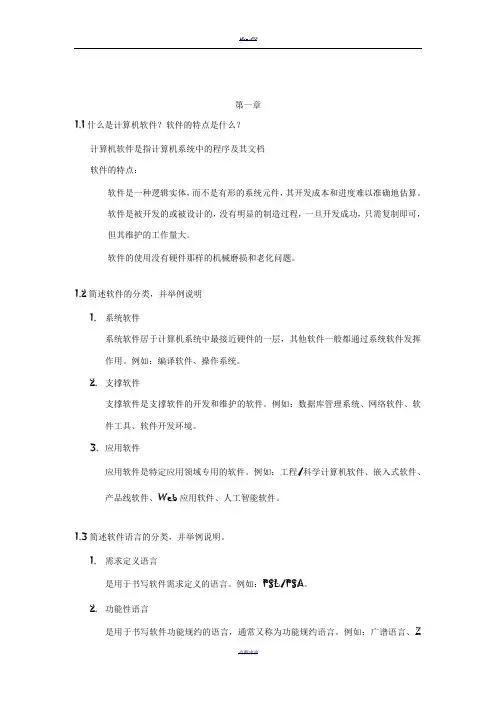
第一章1.1什么是计算机软件?软件的特点是什么?计算机软件是指计算机系统中的程序及其文档软件的特点:软件是一种逻辑实体,而不是有形的系统元件,其开发成本和进度难以准确地估算。
软件是被开发的或被设计的,没有明显的制造过程,一旦开发成功,只需复制即可,但其维护的工作量大。
软件的使用没有硬件那样的机械磨损和老化问题。
1.2简述软件的分类,并举例说明1.系统软件系统软件居于计算机系统中最接近硬件的一层,其他软件一般都通过系统软件发挥作用。
例如:编译软件、操作系统。
2.支撑软件支撑软件是支撑软件的开发和维护的软件。
例如:数据库管理系统、网络软件、软件工具、软件开发环境。
3.应用软件应用软件是特定应用领域专用的软件。
例如:工程/科学计算机软件、嵌入式软件、产品线软件、Web应用软件、人工智能软件。
1.3简述软件语言的分类,并举例说明。
1.需求定义语言是用于书写软件需求定义的语言。
例如:PSL/PSA。
2.功能性语言是用于书写软件功能规约的语言,通常又称为功能规约语言。
例如:广谱语言、Z语言。
3.设计性语言是用于书写软件设计规约的语言。
例如:PDL。
4.实现性语言也称为程序设计语言,是用于书写计算机程序的语言。
例如:C、java、PROLOG、FORTRAN、COBOL、Modula。
5.文档语言是用于书写软件文档的语言。
通常用自然语言或半形式化语言书写。
1.4什么是软件工程?软件工程是应用计算机科学、数学及管理科学等原理,开发软件的工程。
软件工程借鉴传统工程的原则、方法,以提高质量、降低成本为目的。
1.5简述软件工程的基本原则。
软件工程原则包括围绕工程设计、工程支持和工程管理所提出的以下4条基本原则。
1.选取适宜的开发模型必须认识需求定义的易变性,采用适宜的开发模型,保证软件产品满足用户的要求。
2.采用合适的设计方法合适的设计方法有助于这些特征的实现,以达到软件工程的目标。
3.提供高质量的工程支撑软件工程项目的质量与开销直接取决于对软件工程所提供的支撑质量和效用。
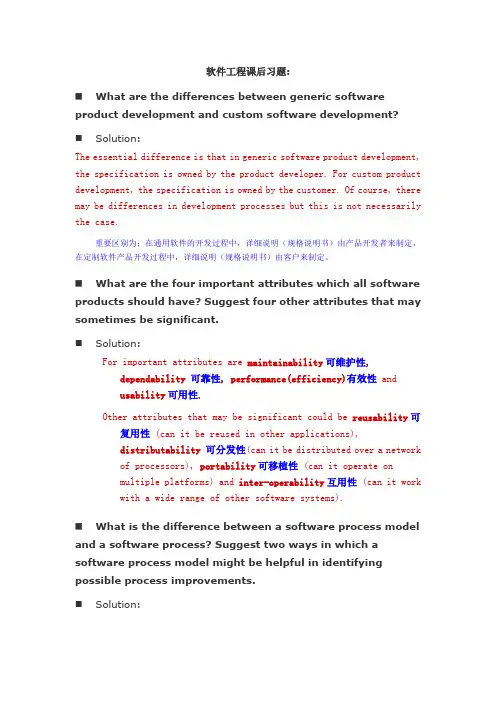
软件工程课后习题:⏹What are the differences between generic software product development and custom software development?⏹Solution:The essential difference is that in generic software product development, the specification is owned by the product developer. For custom product development, the specification is owned by the customer. Of course, there may be differences in development processes but this is not necessarily the case.重要区别为:在通用软件的开发过程中,详细说明(规格说明书)由产品开发者来制定,在定制软件产品开发过程中,详细说明(规格说明书)由客户来制定。
⏹What are the four important attributes which all software products should have? Suggest four other attributes that may sometimes be significant.⏹Solution:For important attributes are maintainability可维护性,dependability 可靠性, performance(efficiency)有效性andusability可用性.Other attributes that may be significant could be reusability可复用性 (can it be reused in other applications),distributability 可分发性(can it be distributed over a networkof processors), portability可移植性 (can it operate onmultiple platforms) and inter-operability互用性 (can it workwith a wide range of other software systems).⏹What is the difference between a software process model and a software process? Suggest two ways in which a software process model might be helpful in identifying possible process improvements.⏹Solution:A software process is what actually goes on when software isdeveloped. A software process model is an abstraction andsimplification of a process. Process models can be used to helpunderstand real processes and to identify which aspects of theseprocesses could be supported by CASE tools. 软件过程就是指在软件开发过程中所做的一些事情。
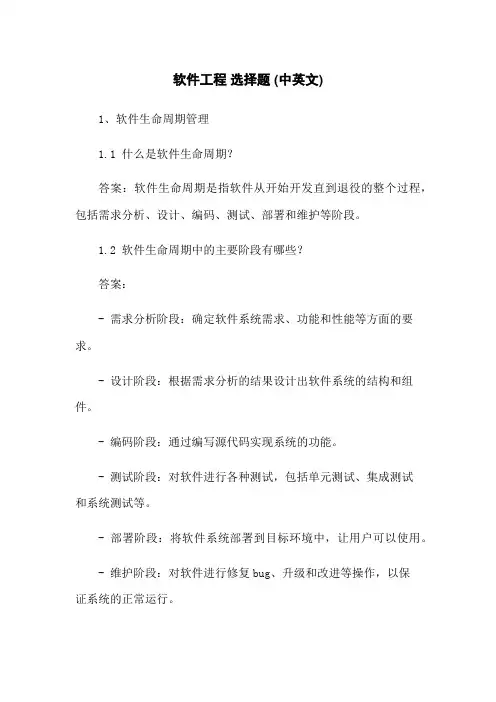
软件工程选择题 (中英文)1、软件生命周期管理1.1 什么是软件生命周期?答案:软件生命周期是指软件从开始开发直到退役的整个过程,包括需求分析、设计、编码、测试、部署和维护等阶段。
1.2 软件生命周期中的主要阶段有哪些?答案:- 需求分析阶段:确定软件系统需求、功能和性能等方面的要求。
- 设计阶段:根据需求分析的结果设计出软件系统的结构和组件。
- 编码阶段:通过编写源代码实现系统的功能。
- 测试阶段:对软件进行各种测试,包括单元测试、集成测试和系统测试等。
- 部署阶段:将软件系统部署到目标环境中,让用户可以使用。
- 维护阶段:对软件进行修复bug、升级和改进等操作,以保证系统的正常运行。
1.3 软件生命周期管理的目标是什么?答案:软件生命周期管理的目标是通过规范的过程和方法来控制软件开发过程,从而提高软件质量、降低风险和成本,以及提高项目交付的可靠性和时间性。
2、需求工程2.1 什么是软件需求?答案:软件需求是对软件系统所需要具备的功能、性能、可靠性和其他特性的描述和规定。
2.2 软件需求的分类有哪些?答案:- 功能需求:描述系统应具备的功能和行为。
- 非功能需求:描述系统性能、可靠性、可用性等方面的要求。
- 用户需求:描述用户对系统的期望和需求。
- 系统需求:将用户需求转化为系统可以理解和实现的需求。
- 验证需求:用于验证软件系统是否满足用户需求的需求。
2.3 软件需求工程的关键活动有哪些?答案:- 需求获取:通过与用户沟通、文档分析等方式获取需求。
- 需求分析:对需求进行分析,识别需求的关联和冲突等问题。
- 需求规格化:将需求用规格化的方式进行描述,如使用用例、功能规格说明等。
- 需求验证:对需求进行验证,包括需求审查、原型验证等。
- 需求管理:对需求进行跟踪和变更管理,确保需求的有效性和一致性。
3、软件设计3.1 什么是软件设计?答案:软件设计是将需求转化为具体的软件系统结构和组件的过程。
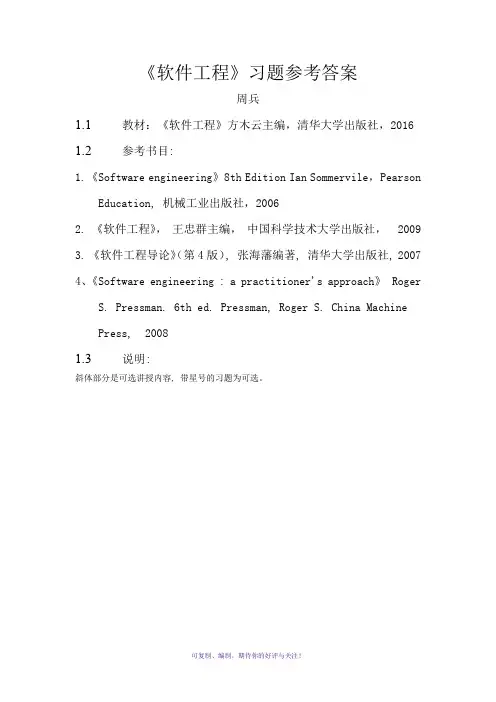
《软件工程》习题参考答案周兵1.1教材:《软件工程》方木云主编,清华大学出版社,2016 1.2参考书目:1.《Software engineering》8th Edition Ian Sommervile,PearsonEducation, 机械工业出版社,20062. 《软件工程》,王忠群主编,中国科学技术大学出版社,20093. 《软件工程导论》(第4版), 张海藩编著, 清华大学出版社, 20074、《Software engineering : a practitioner's approach》 RogerS. Pressman. 6th ed. Pressman, Roger S. China MachinePress, 20081.3说明:斜体部分是可选讲授内容, 带星号的习题为可选。
第1章软件工程学概述1.1习题A.1什么是软件?软件可以分为哪些类?p11答:软件是程序、数据及相关文档的完整集合。
软件可分为通用软件和定制软件。
A.2 *什么是软件危机及其表现?p11答:软件危机是指在计算机软件的开发和维护过程中所遇到的一系列严重问题。
软件危机包含下述两方面的问题:如何开发软件,以满足对软件日益增长的需求;如何维护数量不断膨胀的已有软件。
具体地说,软件危机主要有以下一些典型表现。
(1) 对软件开发成本和进度的估计常常很不准确。
(2) 用户对“已完成的”软件系统不满意的现象经常发生。
(3) 软件产品的质量往往靠不住。
(4) 软件常常是不可维护的。
(5) 软件通常没有适当的文档资料。
(6) 软件成本在计算机系统总成本中所占的比例逐年上升。
(7) 软件开发生产率提高的速度,远远跟不上计算机应用迅速普及深入的趋势。
A.3什么是软件工程?p11答:软件工程是指导计算机软件开发和维护的一门工程学科。
采用工程的概念、原理、技术和方法来开发与维护软件,把经过时间考验而证明正确的管理技术和当前能够得到的最好的技术方法结合起来,以经济地开发出高质量的软件并有效地维护它,这就是软件工程。
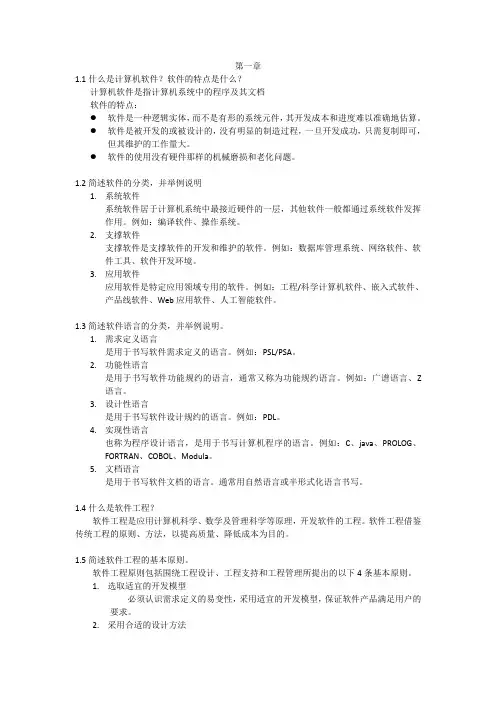
第一章1.1什么是计算机软件?软件的特点是什么?计算机软件是指计算机系统中的程序及其文档软件的特点:●软件是一种逻辑实体,而不是有形的系统元件,其开发成本和进度难以准确地估算。
●软件是被开发的或被设计的,没有明显的制造过程,一旦开发成功,只需复制即可,但其维护的工作量大。
●软件的使用没有硬件那样的机械磨损和老化问题。
1.2简述软件的分类,并举例说明1.系统软件系统软件居于计算机系统中最接近硬件的一层,其他软件一般都通过系统软件发挥作用。
例如:编译软件、操作系统。
2.支撑软件支撑软件是支撑软件的开发和维护的软件。
例如:数据库管理系统、网络软件、软件工具、软件开发环境。
3.应用软件应用软件是特定应用领域专用的软件。
例如:工程/科学计算机软件、嵌入式软件、产品线软件、Web应用软件、人工智能软件。
1.3简述软件语言的分类,并举例说明。
1.需求定义语言是用于书写软件需求定义的语言。
例如:PSL/PSA。
2.功能性语言是用于书写软件功能规约的语言,通常又称为功能规约语言。
例如:广谱语言、Z 语言。
3.设计性语言是用于书写软件设计规约的语言。
例如:PDL。
4.实现性语言也称为程序设计语言,是用于书写计算机程序的语言。
例如:C、java、PROLOG、FORTRAN、COBOL、Modula。
5.文档语言是用于书写软件文档的语言。
通常用自然语言或半形式化语言书写。
1.4什么是软件工程?软件工程是应用计算机科学、数学及管理科学等原理,开发软件的工程。
软件工程借鉴传统工程的原则、方法,以提高质量、降低成本为目的。
1.5简述软件工程的基本原则。
软件工程原则包括围绕工程设计、工程支持和工程管理所提出的以下4条基本原则。
1.选取适宜的开发模型必须认识需求定义的易变性,采用适宜的开发模型,保证软件产品满足用户的要求。
2.采用合适的设计方法合适的设计方法有助于这些特征的实现,以达到软件工程的目标。
3.提供高质量的工程支撑软件工程项目的质量与开销直接取决于对软件工程所提供的支撑质量和效用。
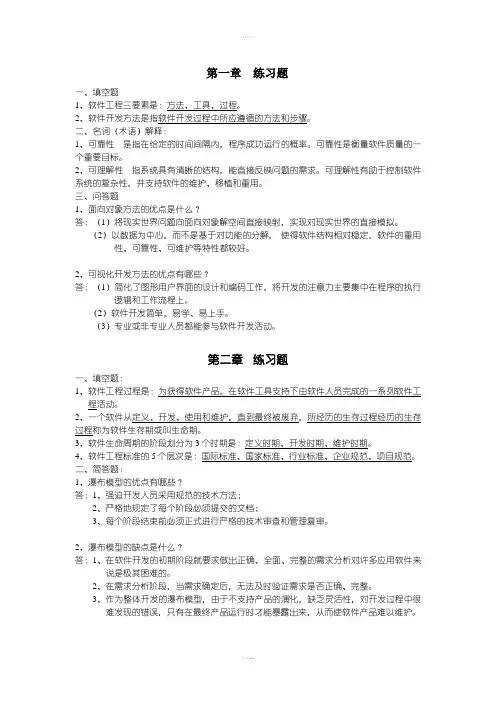
第一章练习题一、填空题1、软件工程三要素是:方法、工具、过程。
2、软件开发方法是指软件开发过程中所应遵循的方法和步骤。
二、名词(术语)解释:1、可靠性---是指在给定的时间间隔内,程序成功运行的概率。
可靠性是衡量软件质量的一个重要目标。
2、可理解性---指系统具有清晰的结构,能直接反映问题的需求。
可理解性有助于控制软件系统的复杂性,并支持软件的维护、移植和重用。
三、问答题1、面向对象方法的优点是什么?答:(1)将现实世界问题向面向对象解空间直接映射,实现对现实世界的直接模拟。
(2)以数据为中心,而不是基于对功能的分解,使得软件结构相对稳定,软件的重用性、可靠性、可维护等特性都较好。
2、可视化开发方法的优点有哪些?答:(1)简化了图形用户界面的设计和编码工作,将开发的注意力主要集中在程序的执行逻辑和工作流程上。
(2)软件开发简单,易学、易上手。
(3)专业或非专业人员都能参与软件开发活动。
第二章练习题一、填空题:1、软件工程过程是:为获得软件产品,在软件工具支持下由软件人员完成的一系列软件工程活动。
2、一个软件从定义、开发、使用和维护,直到最终被废弃,所经历的生存过程经历的生存过程称为软件生存期或叫生命期。
3、软件生命周期的阶段划分为3个时期是:定义时期、开发时期、维护时期。
4、软件工程标准的5个层次是:国际标准、国家标准、行业标准、企业规范、项目规范。
二、简答题:1、瀑布模型的优点有哪些?答:1、强迫开发人员采用规范的技术方法;2、严格地规定了每个阶段必须提交的文档;3、每个阶段结束前必须正式进行严格的技术审查和管理复审。
2、瀑布模型的缺点是什么?答:1、在软件开发的初期阶段就要求做出正确、全面、完整的需求分析对许多应用软件来说是极其困难的。
2、在需求分析阶段,当需求确定后,无法及时验证需求是否正确、完整。
3、作为整体开发的瀑布模型,由于不支持产品的演化,缺乏灵活性,对开发过程中很难发现的错误,只有在最终产品运行时才能暴露出来,从而使软件产品难以维护。
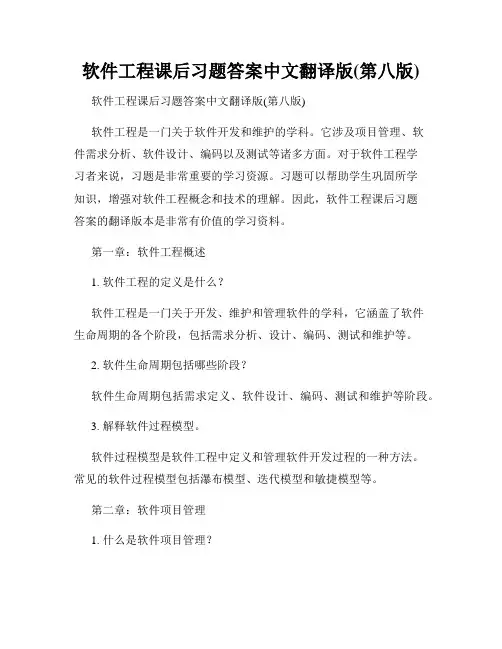
软件工程课后习题答案中文翻译版(第八版)软件工程课后习题答案中文翻译版(第八版)软件工程是一门关于软件开发和维护的学科。
它涉及项目管理、软件需求分析、软件设计、编码以及测试等诸多方面。
对于软件工程学习者来说,习题是非常重要的学习资源。
习题可以帮助学生巩固所学知识,增强对软件工程概念和技术的理解。
因此,软件工程课后习题答案的翻译版本是非常有价值的学习资料。
第一章:软件工程概述1. 软件工程的定义是什么?软件工程是一门关于开发、维护和管理软件的学科,它涵盖了软件生命周期的各个阶段,包括需求分析、设计、编码、测试和维护等。
2. 软件生命周期包括哪些阶段?软件生命周期包括需求定义、软件设计、编码、测试和维护等阶段。
3. 解释软件过程模型。
软件过程模型是软件工程中定义和管理软件开发过程的一种方法。
常见的软件过程模型包括瀑布模型、迭代模型和敏捷模型等。
第二章:软件项目管理1. 什么是软件项目管理?软件项目管理是对软件开发项目进行规划、组织、指导和控制的过程,目的是确保项目按时、按质量要求完成。
2. 软件项目管理的主要任务是什么?软件项目管理的主要任务包括项目计划、项目组织、项目沟通、项目风险管理和项目控制等。
3. 解释关键路径法。
关键路径法是一种用于确定项目进度安排和资源分配的方法。
通过确定项目中的关键路径,可以确保项目按时完成。
第三章:软件需求分析1. 软件需求分析的目的是什么?软件需求分析的目的是确定软件系统的功能和性能需求,并将其转化为具体的需求规格说明。
2. 软件需求分析的主要活动包括哪些?软件需求分析的主要活动包括需求获取、需求建模、需求验证和需求管理等。
3. 解释用例图。
用例图是一种用于描述系统功能的图形化表示方法。
用例图可以帮助分析师和开发人员理解系统与用户之间的交互。
第四章:软件设计1. 软件设计的目标是什么?软件设计的目标是将需求规格转化为可执行的软件系统,并满足性能、可维护性和可扩展性等要求。
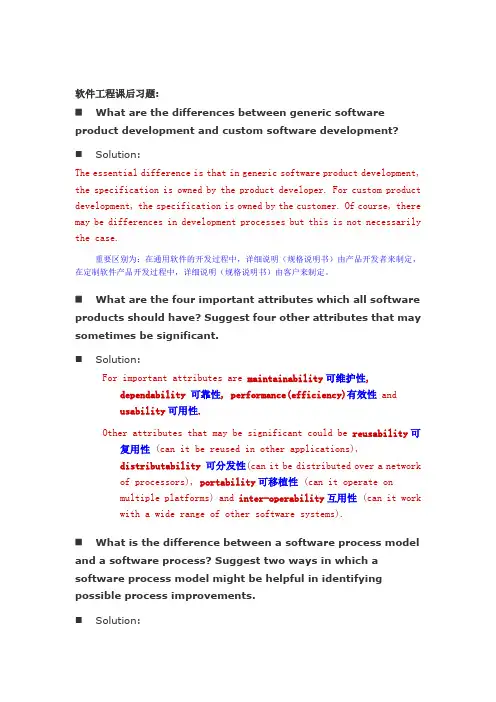
软件工程课后习题:⏹What are the differences between generic software product development and custom software development?⏹Solution:The essential difference is that in generic software product development, the specification is owned by the product developer. For custom product development, the specification is owned by the customer. Of course, there may be differences in development processes but this is not necessarily the case.重要区别为:在通用软件的开发过程中,详细说明(规格说明书)由产品开发者来制定,在定制软件产品开发过程中,详细说明(规格说明书)由客户来制定。
⏹What are the four important attributes which all software products should have? Suggest four other attributes that may sometimes be significant.⏹Solution:For important attributes are maintainability可维护性,dependability 可靠性, performance(efficiency)有效性andusability可用性.Other attributes that may be significant could be reusability可复用性 (can it be reused in other applications),distributability 可分发性(can it be distributed over a networkof processors), portability可移植性 (can it operate onmultiple platforms) and inter-operability互用性 (can it workwith a wide range of other software systems).⏹What is the difference between a software process model and a software process? Suggest two ways in which a software process model might be helpful in identifying possible process improvements.⏹Solution:A software process is what actually goes on when software isdeveloped. A software process model is an abstraction andsimplification of a process. Process models can be used to helpunderstand real processes and to identify which aspects of theseprocesses could be supported by CASE tools. 软件过程就是指在软件开发过程中所做的一些事情。

软件工程课后习题:⏹What are the differences between generic software product development and custom software development?⏹Solution:The essential difference is that in generic software product development, the specification is owned by the product developer. For custom product development, the specification is owned by the customer. Of course, there may be differences in development processes but this is not necessarily the case.重要区别为:在通用软件的开发过程中,详细说明(规格说明书)由产品开发者来制定,在定制软件产品开发过程中,详细说明(规格说明书)由客户来制定。
⏹What are the four important attributes which all software products should have? Suggest four other attributes that may sometimes be significant.⏹Solution:For important attributes are maintainability可维护性,dependability 可靠性, performance(efficiency)有效性andusability可用性.Other attributes that may be significant could be reusability可复用性 (can it be reused in other applications),distributability 可分发性(can it be distributed over a networkof processors), portability可移植性 (can it operate onmultiple platforms) and inter-operability互用性 (can it workwith a wide range of other software systems).⏹What is the difference between a software process model and a software process? Suggest two ways in which a software process model might be helpful in identifying possible process improvements.⏹Solution:A software process is what actually goes on when software isdeveloped. A software process model is an abstraction andsimplification of a process. Process models can be used to helpunderstand real processes and to identify which aspects of theseprocesses could be supported by CASE tools. 软件过程就是指在软件开发过程中所做的一些事情。
第一章软件工程概述软件工程的基本原则是什么?1,抽象:采用分层次抽象,自顶向下逐层细化的办法控制软件开发过程的复杂性。
2,模块化:模块化有助于信息隐蔽和抽象,有助于表示复杂的系统。
3,信息隐蔽:将模块化设计成“黑箱”,实现的细节隐蔽在模块内部,不让模块的使用直接访问,这就是信息封装。
4,局部化:保证模块之间具有松散的耦合,模块内部具有较强的内聚,这有助于控制模块的复杂性5,一致性:整个软件系统使用一致的概念符号和术语。
6,完整性:软件系统不丢失任何重要成分,可以完全实现系统所要求功能的程度。
7,不可验证性:易于检查、测试、评审,确保系统的正确性。
第二章可行性研究选择题1,研究开发所需要的成本和资源属于可行性研究中(经济可行性)研究的一方面。
2,可行性分析研究的目的是(项目值得开发与否)。
3,软件分析的第一步要做的工作在于(分析系统开发的可行性)。
4,可行性研究目的主要在于(用最小的代价确定问题定义阶段所确定的目标和规模是否可实现,可解决)。
5,软件可行性分析是着重确定系统的目标和规模。
对功能,性能及约束条件的分析应属于下列(技术可行性分析)。
简答题简述可行性研究的步骤?1,复查系统规模和目标2,研究目前正在使用的系统3,导出新系统的高层逻辑模型4,重新定义问题5,导出和评价供选择方案6,推荐一个方案并说明理由7,推荐行动方针8,书写计划任务书9,提交审查应用题设计一个软件的开发成本为5万元,寿命为3年。
未来3年的每年收益预计为22000元,24000元,26620元,银行年利率为10%。
试对此项目进行成本效益分析,以决定其经济可行性。
答:设银行的年利率是10%,则下列出每年的收益第一年:22000/1.1=20000第二年:24000/1.21=19834.71第三年:26620/1.331=20000因此:现有值收益为20000+19834.71+20000=59834.71投资回收期2+10165/20000=2.51纯收入59835-50000=9834.71第三章需求分析需求分析的原则有哪些?1.需求分析方法应该容易被用户理解。
软件⼯程课后习题答案中⽂翻译版(第⼋版)软件⼯程课后习题:1.解释为什么专业化软件不仅仅包括为⽤户所开发程序?专业化软件在开发上与在与软件就有所不同。
专业软件通常是由团队开发⽽⾮个⼈,除了开发者外还有其他的⽤户使⽤。
如果你的软件有别的⽤户,别的⼯程师会去修改的话,你就必须提供除了程序源码之外的其它附带信息。
因此,系统通常除了包含⼀些单独的程序还有⽤于这些程序的配置⽂件,可能还包括描述系统结构的系统⽂档和解释如何使⽤该系统的⽤户⽂档,以及告知⽤户下载最新产品的Web站点。
2.通⽤软件产品开发和定制软件开发直接有什么不同?这在实际应⽤中对通⽤软件产品⽤户意味着什么?(1)重要区别为:在通⽤软件的开发过程中,详细说明(规格说明书)由产品开发者来制定,在定制软件产品开发过程中,详细说明(规格说明书)由客户来制定开发者必须按客户要求进⾏开发。
(2)意味着通⽤软件很难满⾜通⽤软件客户的特殊需求。
如可靠性、安全性、快捷性。
3.软件产品应该具有与的4重要属性是那些?另外列举出4个可能有意义的属性。
重要属性:可维护性、可依赖性和安全性、有效性和可⽤性。
可能有意义的属性:可复⽤性、可分发性、可移植性和互⽤性。
4.除了异质性挑战、业务和社会的变⾰、安全和可信,说出软件⼯程在21世纪的可能⾯临的其它问题和挑战。
交付上的挑战:许多传统的软件⼯程技术需要耗费⼤量的时间,⽤于提⾼软件质量。
⽽今天的软件制作必须响应快、更换迅速,⽀持软件也必须同样快地进⾏更换。
交付上的挑战是:在不损及系统质量的前提下,缩短⼤型、复杂系统的移交时间。
5.参论的应⽤类型,照1.1.2节讨举例介绍为什么设计和开发不同类型的应⽤需要专门的软件技术。
如汽车上年的嵌⼊式控制系统对安全性要求极⾼,在车上安装是要烧制到ROM 中在这⾥的交互在这⾥是很少的(或许根本就没有)。
基于Web式系统更适合⽤于迭代式开发和交互。
⽽基于Web的系统编程使⽤的如Ruby⼀类的脚本语⾔,完全不适合嵌⼊式系统⼯程。
软件工程课后习题参考答案1.简述软件开发的本质答: 软件开发的本质就是实现问题空间的概念和处理逻辑到解空间的概念和处理逻辑之间的映射。
P192.简述实施软件开发的基本途径。
答: 实施软件开发的基本途径是系统建模。
所谓系统建模,是指运用所掌握的知识,通过抽象,给出该系统的一个结构——系统模型。
P193.简述何谓模型以及软件开发中所涉及的模型。
答: 模型是一个抽象。
该抽象是在意图所确定的角度和抽象层次对物理系统的一个描述,描述其中的成分和成分之间所具有的特定语义的关系,还包括对该系统边界的描述。
软件开发中所涉及的模型可分为两大类,一类称为概念模型,描述了系统是什么;另一类统称为软件模型,描述了实现概念模型的软件解决方案。
4.简述软件开发所涉及的两大类技术。
答: 软件开发所涉及的两大类技术为: 一是求解软件的开发逻辑,二是求解软件的开发手段。
5、简述需求与需求规约的基本性质。
答:需求的基本性质:1) 必要的,该需求是用户所要求的。
2) 无歧义的,该需求只能用一种方式解释。
3) 可测的,该需求是可进行测试的。
4) 可跟踪的,该需求可从一个开发阶段跟踪到另一个阶段。
5) 可测量的,该需求是可测量的。
需求规约的基本性质:1) 重要性和稳定性程度: 按需求的重要性和稳定性,对需求进行分级。
2) 可修改的: 在不过多地影响其他需求的前提下,可以容易地修改一个单一需求。
3)完整的:没有被遗漏的需求。
4)一致的:不存在互斥的需求。
6、简述软件需求的分类答:软件需求可以分为两大类:一类是功能需求,一类是非公能需求,而非公能需求可分为性能需求,外部接口需求、功能需求7、举例说明功能需求和非功能需求之间的基本关系。
答:非功能需求可作用于一个或多个功能需求,例如非功能需求可作用于一个或多个功能需求其中,非功能需求1作用于功能需求1和功能需求3等;非功能需求2作用于功能需求2等。
P248、有哪几种常用的初始需求发现技术?答:有5种常用的需求发现技术:自悟、交谈、观察、小组会和提炼。
一、选择题1.下列耦合度表示中,最弱的耦合形式是( )。
A.特征耦合 B.公共耦合 C.数据耦合 D.数据结构2.一个模块传送给另一模块的参数是由单个数据项组成的数组,它属于( )耦合。
A.数据型B、复合型C、内容型D、公共型3.PAD(Problem Analysis Diagram)图是一种( )工具。
A.系统描述 B.详细设计 C.测试 D.编程辅助4.下列系统设计工具中,( )不属于详细设计工具。
A.N—S图 B.数据流图 C.程序流程图 D.PAD 5.程序流程图、N-S图和PAD图是( )使用的表达工具。
A.设计阶段的概要设计B.设计阶段的详细设计C.编码阶段D.测试阶段二、填空题1.详细设计的任务是确定每个模块的内部特性,即模块的算法、。
2.是对软件结构中模快间关联程度的一种度量。
3.独立路径是指包括一组以前没有处理的语句或条件的一条路径。
从程序图来看,一条独立路径是至少包含有一条的边的路径。
4.成本效益分析的目的是从角度评价开发一个项目是否可行。
三、应用题1.系统设计的内容是什么?答案:一、1.C 2.A 3.B 4.B 5.B二、1.使用的数据2.耦合度3.在其他独立路径中未有过4.经济三、1.系统设计阶段先从高层入手,然后细化。
系统设计要决定整个结构及风格,这种结构为后面设计阶段的更详细策略的设计提供了基础。
(1)系统分解。
系统中主要的组成部分称为子系统,子系统既不是一个对象也不是一个功能,而是类、关联、操作、时间和约束的集合。
每次分解的各子系统数目不能太多,最底层子系统称为模块。
(2)确定并发性。
分析模型、现实世界及硬件中不少对象均是并发的。
系统设计的一个重要目标就是确定哪些是必须同时动作的对象,哪些不是同时动作的对象。
后者可以放在一起,而综合成单个控制线或任务。
(3)处理器及任务分配。
各并发子系统必须分配给单个硬件单元,要么是一个一般的处理器,要么是一个具体的功能单元,必须完成下面的工作:估计性能要求和资源需求,选择实现子系统的硬软件,将软件子系统分配给各处理器以满足性能要求和极小化处理器之间的通信,决定实现各子系统的各物理单元的连接。
Chapter 1 An Introduction to Software Engineering1. Why software engineering is important?软件工程由应对软件危机也产生,软件工程的发展极大地完善了我们的软件。
软件工程的研究使得我们对软件开发活动有个更深入的了解,并且已经找到了进行软件描述、设计和实现的有效方法。
软件工程中新的标记发和工具大大降低了制作大型、复杂系统的工作量2. What is software? What is software engineering?软件工程是一门工程学科,包括了软件开发的各个方面,从最初的系统描述一直到使用后的系统维护,都属于其学科范畴。
3. What is the difference between software engineering and computer science?计算机科学研究的是构成计算机和软件系统基础的有关理论和方法,耳软件工程则研究软件制作中的实际问题。
计算机科学侧重理论和基础; 软件工程侧重软件开发和交付的实际活动。
4. What are the attributes of good software?软件除了提供基本的功能,对用户来说是还应该是可维护的、可依赖的和可接受的。
可维护性,软件必须能够不断变化以满足变化;可依赖性,软件必须可以被信赖;有效性,软件不能浪费系统资源;可用性,使用起来比较容易5. What is CASE?CASE 工具是一些软件系统,被设计成支持软件过程中的常规活动,如编辑设计图表、检查图表的连贯性、跟踪已经运行的程序测试等。
6. What is the difference between software engineering and system engineering?系统工程侧重于计算机系统开发的所有方面,包括硬件、软件和处理工程。
软件工程是整个系统的一部分,它关心系统中基础软件、控制软件、应用软件和数据库的开发。
Part 1 OverviewChapter 1 Introduction1.1 FAQs about software engineering1.2 Professional and ethical responsibility Chapter 2 Socio-technical systems2.1 Emergent system properties2.2 Systems engineering2.3 Organisations, people and computer systems 2.4 legacy systemsChapter 3 Critical systems3.1 A simple safety-critical system 463.2 System dependability 473.3 Availability and reliability 513.4 Safety 553.5 Security 58Chapter 4 Software processes4.1 Software process models 654.2 Process iteration 714.3 Process activities 744.4 The Rational Unified Process 824.5 Computer-Aided Software Engineering 85 Chapter 5 Project management 925.1 Management activities 945.2 Project planning 965.3 Project scheduling 995.4 Risk management 104 RequirementsChapter 6 Software requirements 6.1 Functional and non-functional requirements6.2 User requirements6.3 System requirements6.4 Interface specification6.5 The software requirements document Chapter 7 Requirements engineering processes7.1 Feasibility studies7.2 Requirements elicitation and analysis7.3 Requirements validation7.4 Requirements managementChapter 8 System models 8.1 Context models8.2 Behavioural models8.3 Data models8.4 Object models8.5 Structured methodsChapter 9 Critical systems specification9.1 Risk-driven specification9.2 Safety specification9.3 Security specification9.4 Software reliability specificationChapter 10 Formal specification 10.1 Formal specification in the software process 10.2 Sub-system interface specification10.3 Behavioural specificationPart 3 DesignChapter 11 Architectural design 11.1 Architectural design decisions11.2 System organisation11.3 Modular decomposition styles11.4 Control styles11.5 Reference architecturesChapter 12 Distributed systems architectures12.1 Multiprocessor architectures12.2 Client-server architectures12.3 Distributed object architectures12.4 Inter-organisational distributed computing Chapter 13 Application architectures13.1 Data processing systems13.2 Transaction processing systems13.3 Event processing systems13.4 Language processing systems Chapter 14 Object-oriented design14.1 Objects and object classes14.2 An object-oriented design process14.3 Design evolutionKey PointsFurther ReadingExercisesChapter 15 Real-time software design15.1 System design15.2 Real-time operating systems15.3 Monitoring and control systems15.4 Data acquisition systemsChapter 16 User interface design 36216.1 Design issues 36616.2 The UI design process 37616.3 User analysis 37816.4 User interface prototyping 38116.5 Interface evaluation 383Part 4 Development 389 Chapter 17 Rapid software development 39117.1 Agile methods 39617.2 Extreme programming 39817.3 Rapid application development 40517.4 Software prototyping 409Chapter 18 Software reuse 415 18.1 The reuse landscape 41818.2 Design patterns 42118.3 Generator-based reuse 42318.4 Application frameworks 42618.5 Application system reuse 428 Chapter 19 Component-based software engineering19.1 Components and component models 19.2 The CBSE process19.3 Component compositionChapter 20 Critical systems development20.1 Dependable processes20.2 Dependable programming20.3 Fault tolerance20.4 Fault-tolerant architecturesChapter 21 Software evolution 21.1 Program evolution dynamics21.2 Software maintenance21.3 Evolution processes21.4 Legacy system evolutionPart 5 Verification and ValidationChapter 22 Verification and validation22.1 Planning verification and validation 22.2 Software inspections22.3 Automated static analysis22.4 Verification and formal methods Chapter 23 Software testing23.1 System testing23.2 Component testing23.3 Tes1 case design23.4 Tes1 automationChapter 24 Critical systems validation24.1 Reliability validation24.2 Safety assurance24.3 Security assessment24.4 Safety and dependability case's ManagementChapter 25 Managing people25.1 Selecting staff25.2 Motivating people25.3 Managing groups25.4 The People Capability Maturity Model Chapter 26 Software cost estimation 61226.1 Software productivity 61426.2 Estimation techniques 62026.3 Algorithmic cost modelling 62326.4 Project duration and staffing 637 Chapter 27 Quality management 64127.1 Process and product quality 64427.2 Quality assurance and standards 645 27.3 Quality planning 65227.4 Quality control 65327.5 Software measurement and metrics 655 Chapter 28 Process improvement 66528.1 Process and product quality 66728.2 Process classification 66928.3 Process measurement 67228.4 Process analysis and modelling 67328.5· Process change 67828.6 The CMMI process improvement framework 680Chapter 29 Configuration management29.1 Configuration management plclnning 29.2 Change management29.3 Version and release management 29.4 System building29.5 CASE tools for configuration managementEmerging TechnologiesSecurity engineering30.1 Security concepts30.2 Security risk management 30.3 Design for security 30.4 System survivabilityService-oriented software e:ngineering31.1 Services as reusable components 31.2 Service engineering31.3 Software development with servicesAspect-oriented software development32.1 The separation of concerns 32.2 Aspects, join points and pointcuts 32.3 Software engineering with aspectsChapter 1 ' IntroductionChapter 2 Socio-technical systemsChapter 3 iii Critical systemsChapter 6 • Software requirementsChapter 7 Requirements engineering processesChapter 8 System modelsChapter 9 Critical systems specificationChapter 10 Formal specificationChapter 11 Architectural designChapter 12 Distributed systems architecturesChapter 13 Application architecturesChapter 14 Object-oriented designChapter 15 Real-time software designChapter 16 User interface designChapter 17 Rapid software developmentChapter 18 Software reuseChapter 19 Component-based software engineeringChapter 20 Critical systems developmentChapter 21 Software evolutionChapter 22 Verification and validationChapter 23 Software testingChapter 24 Critical systems validationChapter 25 Managing people。